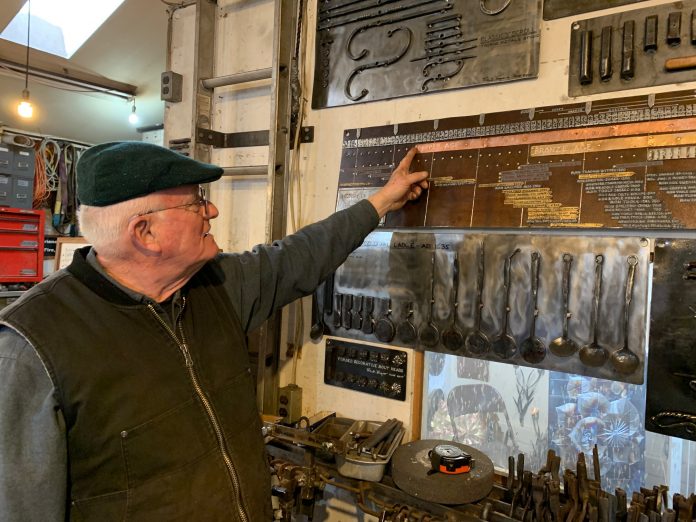Paul Thorne reinvented himself many times throughout his life. He grew up in Seattle, then took on roles as diverse as cowboy and corporate vice president before finding his true calling. Fortunately for those who appreciate fine art, he discovered a passion for blacksmithing about 40 years ago while living in California. When Paul, his wife, Kim, and their three boys returned home to the Pacific Northwest in 1988, the transition to full-time artist/blacksmith began. Now Paul Thorne has his own blacksmith shop, Thorne Metals, in Anacortes.
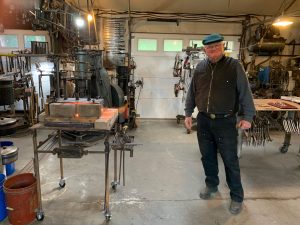
A Fascinating Path
Paul’s path to blacksmithing is as interesting as the craft itself. After working as a cowboy in southeastern Washington, learning machining and scraping by in school, Paul enlisted in the Marine Corps. He served as a combat marine in Vietnam with the 9th Marine Amphibious Brigade during the 1968 Tet Offensive. Afterward, he enrolled at Washington State University. Following the marines, Paul says that, “college felt like the easiest thing I had ever done.”
Finding his political science major ill-fitting in his junior year, Paul started over at Western Washington University in Bellingham and majored in industrial design. While there, he also worked as a commercial diver and began developing underwater tools, vehicles and life support systems. Upon graduation, he took a job designing systems for a leading ocean services firm in Virginia. He traveled the globe as a saturation diving field engineer, working in the waters of the North Sea, the Far East, the Mediterranean and South America.
Deep water diving is called “saturation diving” because of the gasses forced into body tissues by the incredible pressure of the depths. Divers can spend up to a month underwater in a small chamber, then days in an even smaller decompression chamber to recover. Deep water divers are “old at age 30!” notes Paul.
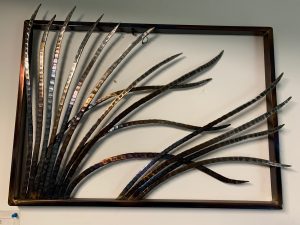
Paul moved inside to the corporate offices and worked on some of the first undersea robots. It was a fascinating chapter, and his talents propelled him into management. As he advanced to the position of vice president, however, he was restless. “The trappings of corporate life—money, prestige, stock options—meant nothing to me,” Paul explains.
Discovering a Calling
At the end of one frustrating day at the office, Paul headed to the garage and forged a tiny fork and spoon out of nails. “For the first time in my life the gears meshed,” he remembers. “It was a startling experience.” He attended a blacksmiths’ conference soon after, and acknowledged an innate sense of how to forge and a passion for the process. He had found his calling.
The transition from corporate vice president to blacksmith began. Over the next several years, the bills were paid with his new company’s work and part time commissions. It was an adjustment for the whole family that coincided with coming back to the Pacific Northwest, and moving the forge from an 8-foot by 8-foot backyard shed to a full-sized studio in Anacortes. “My family supported me all the way,” Paul says.
Paul is an advocate for people looking to discover their calling. He uses his experience as an example of changes that can happen when people find their own gifts. It’s not easy or as lucrative as other work, but the satisfaction and peace of mind are worth it. “The supportive people and the art environment in the Skagit Valley are tremendous assets,” Paul believes.
Inside Paul’s World
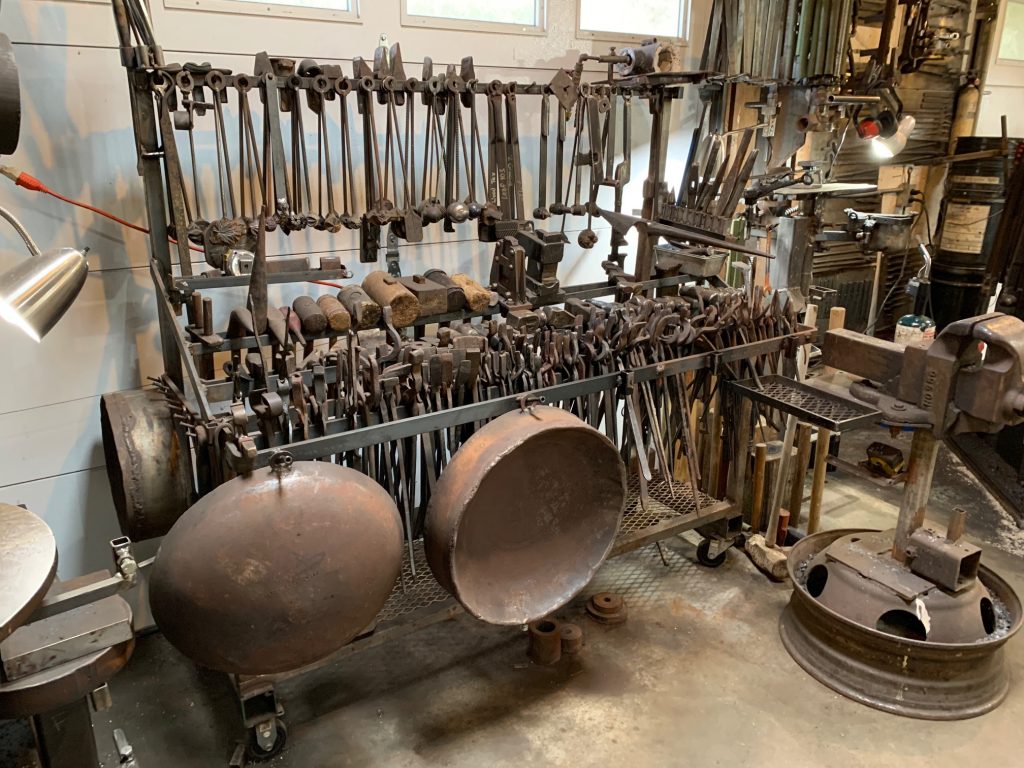
When you step into Paul’s forge two things will strike you. First, you’ll see an astonishing collection of tools and equipment. Then you’ll notice how well the studio is organized. Project patterns hang from the ceiling and many different hammers and tongs line a rack next to the huge anvil. “I use every one of them,” says Paul. He has made nearly all his tools himself. That’s what blacksmiths do.
Machining and field engineering abilities, coupled with an industrial design degree, formed the solid foundation for Paul’s blacksmithing career. He has made custom fireplace screens, decorative window grills, staircases, railings, gates, kitchen hardware, furniture and sculpture. He also creates his own art pieces in copper and iron, selling them in galleries. “My goal with each piece is beauty,” he shares.
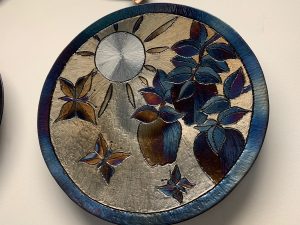
There are various ways to add interest to each piece including texture, heat patina and decorative stamps. When Paul wants a special texture, such as the pattern on a decorative plate, he carves a carbon steel tool to do it. This die is hammered into the plate’s red-hot surface. Color is another option. Paul brings colors to his designs by heating the metal and adding heat patina. “By knowing the predictable sequence of colors that appear, you can literally paint with heat,” he explains.
Today’s Work
While Paul continues creating and has a small gallery of recent work, today he’s most engaged in teaching blacksmithing. “I’ve got to pass this on,” he says. “My heart is in teaching.” He holds classes at his forge where students include young and old, men and women. “Women make awesome blacksmiths because they understand you have to plan and use technique with the metal, not overpower it,” Paul notes. Kids can try a class with a parent too, and students learn a lot in just a day. “Taking home an ‘Iron Age’ knife in one session is very satisfying,” Paul feels.
The State of Smithing
According to Paul, who’s a history buff and teaches metal history classes through the Anacortes Senior College, humans started using metals about 7,000 B.C. Early cultures moved from chipping stone tools before 10,000 B.C. to working with copper, then bronze and finally iron around 1,000 B.C. Mining iron and other metals helped drive the establishment of more advanced societies. A highpoint of smithing was during medieval times when village smiths created beautiful sculpture and ironwork for cathedrals, plus tools, weapons and household necessities. Every level of society depended on smiths to make items for modern life.
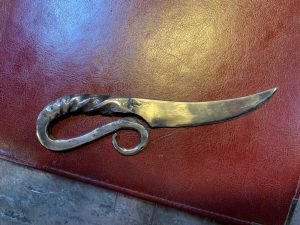
Advanced metal skills virtually disappeared after the Industrial Revolution, the Great Depression and the two World Wars. Starting in the 1970s, the craft began to experience a worldwide renaissance. Growing demand for hand forged architectural and artistic ironwork has brought blacksmithing back.
Today, there are about 5,000 artist/blacksmiths in the U.S., primarily hobbyists. Paul is one of about 500 who practice as full-time professionals; about a third of them are women.
Asked what it takes to be a smith Paul has just one answer, “You have to really want to do it.” Learn about the modern-day blacksmith of Anacortes, find out about classes and see Paul’s work on the Thorne Metals website.
































